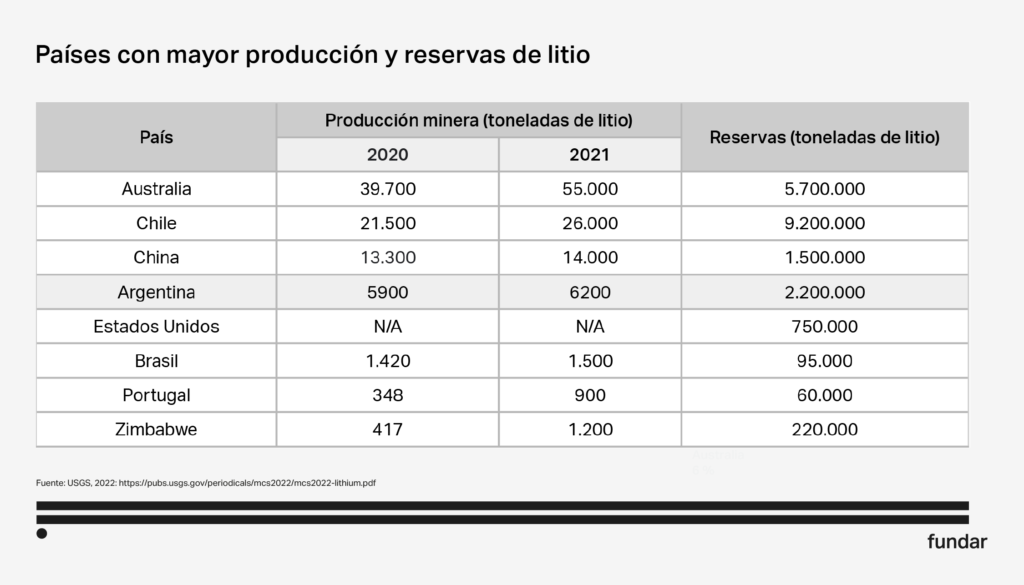What does lithium mean for Argentina?
The climate crisis has become one of the greatest global challenges of the 21st century. Faced with this scenario, one of the strategies for socio-ecological transition is to move from a fossil fuel-intensive energy matrix to a mineral-intensive one. Lithium mining is one of the key inputs to meet these objectives.
Latin American countries play a key role in the transition process towards more sustainable energy matrices. Global reserves are mainly concentrated in Australia and the Andean salt flats of the countries known as the “lithium triangle”: Argentina, Bolivia and Chile. In this context, Argentina’s role is central. It is the world’s second-largest producer of lithium from brine and the fourth-largest from any type of extraction.

The prominence of lithium in the energy transition places mining as a key factor in this process. The socio-environmental challenges of lithium mining need to be addressed. Reflecting on the governance systems of the activity would allow for the fulfilment of rights, participation and environmental sustainability.
What is socio-environmental governance of lithium mining?
Socio-environmental governance of mining is the decision-making process over natural resources.
In recent years, civil society complaints about the environmental and social impacts of mining have increased. When it comes to lithium, questions focus on the ecological imbalances generated by the overconsumption of water in extremely arid territories.
Competing economic models and weak institutional linkages generate mistrust in the capacity to ensure socio-environmental sustainability and accountability. Both the lack of participation of local communities in decision-making and limitations in the availability and accessibility of up-to-date public environmental information are denounced.
In this sense, the development of mining activity in Argentina is characterised by a high level of social conflict. According to the study “Cartography of Mining Conflict in Argentina“, Argentina is the country with the fourth highest number of socio-environmental mining conflicts after Mexico, Chile and Peru. In total, more than 50% of mining projects are cancelled or temporarily suspended due to social resistance.
It is necessary to observe the institutional frameworks to analyse how the instances of public participation, dialogue and relations are foreseen. Which are the authorities involved in the process of granting the environmental licence for this type of project? What is the degree of accessibility to the related information?
Lithium mining in Argentina
In the provinces of Jujuy, Salta and Catamarca, where Argentina’s lithiferous reserves are concentrated, there is no uniform strategy for managing their resources. The instances of public participation and their articulation with the process of free, prior and informed consultation (FPIC), the environmental impact assessment (EIA) procedure and its effective implementation present gaps between jurisdictions.
These gaps must be analysed from a human rights approach, which is one of the six Guiding Principles of the United Nations Framework for Sustainable Development Cooperation. This approach rests on two pillars. On the one hand, it places the state as responsible for guaranteeing, promoting and protecting citizens’ rights. On the other hand, it values the power of citizens to defend, participate and demand the fulfilment of their rights.
This indicates that the state is key to designing the rules and creating enforcement bodies.
At the same time, the socio-environmental issue is also important for the private sector involved in the production link of the chain. Automotive companies and battery producers, the main consumers of lithium, are facing an in-depth analysis of the sustainability of their practices;
Natural resources: mining policy and provincial states
Argentina is a country constitutionally organised as a federal state, made up of 24 jurisdictions. In this configuration, competences and powers are belonging to the provinces, exclusive powers of the federal government, and others that are exercised jointly or in a complementary manner;
The regulation of mining policy is a power of the national State since it is the National Congress that has the power to dictate the Mining Code. However, Article 124 of the National Constitution establishes that natural resources belong to the provinces. Therefore, alongside the Mining Code, local regulations coexist. Local jurisdictions adhere to and apply the Code or issue their regulations in line with the National Code. In this sense, lithium falls within this dual regulatory framework.
Access rights and free, prior and informed consultation: key to socio-environmental governance of lithium mining
The General Environmental Law (LGA) provides that activities that may degrade the environment or affect the quality of life of the population must be subject to an environmental impact assessment (EIA) procedure.
The first aspect in which the LGA goes deeper is the implementation of instances of public participation. The second is access to information as a right and a duty of the authorities. The importance of having environmental public information was reflected in the enactment of the Law on Minimum Requirements for the Regime of Free Access to Environmental Public Information.

Environmental law took on another dimension with the ratification by our country of the Escazu Agreement (Law No. 27566). As a law in our country, the provisions of this Agreement are added to the minimum budget laws. In this way, it not only has an impact on the national state but also sub-national political units.
The other critical issue is the relationship between communities and indigenous peoples. Mining activity in high Andean ecosystems overlaps with territories that have been used and occupied by local populations for more than 10,000 years.

Institutionality: environmental licensing and free, prior and informed consultation
The institutional analysis focuses on identifying the competent body or entity for the granting of environmental licences for lithium mining projects within the framework of the Environmental Impact Assessment (EIA) procedure in each of the selected provinces.
The Environmental Impact Assessment (EIA) procedure is the process of identifying, predicting, assessing and mitigating the potential impact of an activity on the environment;

Identifying the authorities that grant environmental licences implies distinguishing which bodies are involved in the analysis of socio-environmental impacts and in what framework this intervention takes place.
Analysing the membership and level of the body involved makes it possible to see the objectives and focus that the authority may have. The degree of legitimacy perceived by society is also a factor to consider. It is not the same to interact with a portfolio that must evaluate the impact of an activity as with another that must promote it economically;
In this regard, the institutional framework faces two challenges. Effectively enforcing current legislation in practice, ensuring contextualised and continuous implementation, and guaranteeing transparency that legitimises interventions.

Access to public environmental information
Access to information should aim to centralise information that is dispersed or difficult to access. Its main objective is to facilitate informed decision-making. To be reliable, it must not only be available, but also use a language suitable for society’s understanding.
This axis is linked to the accessibility and transparency of socio-environmental information on mining projects. Accessibility is measured by ease of access. It implies being able to access information through open and public platforms, without the need to make an access request. Transparency is linked to the availability of continuously updated information from government and companies.
This is based on an approach in which the rights to information and participation are intimately linked. Thus, the degree of accessibility will have a direct effect on the quality of public participation in the environmental decision-making process.

Public participation
The Escazú Agreement distinguishes between two types of public participation. On the one hand, activities and processes are linked to the granting of environmental authorisations. On the other hand, decision-making processes related to matters of public interest.
In addition, the section aims to identify local regulations on public participation required within the Environmental Impact Assessment procedures. This characterisation serves to identify the legislation that is established at the provincial level with respect to the instances of public participation foreseen for lithium mining projects.

Rethinking governance: key challenges and management proposals
Recommendation: empower the environmental authority both in the conduct of the processes and in its technical capacity.
The rule of environmental law requires that institutions are given clear and transparent mandates. These should detail the jurisdiction, objectives and authority of the institution, and be coordinated with other institutions.
Recommendation: Create web portals that centralise information related to the environmental licensing of mining projects.
Clarity in the design, content and formats of web portals is the first step in generating public engagement. The availability of information ensures that the public can form a critical and informed opinion, reducing knowledge asymmetries.
Recommendation: institutionalise stages, methodologies, roles and responsibilities of the actors involved in public participation bodies;
The implementation of public participation instances should be detailed and their objectives made explicit. Failure to meet the requirements and expectations of civil society can lead to detrimental and negative outcomes for the resolution of the conflict or problem in question.
Recommendation: incorporate public participation as a requirement in the submission of the Environmental Impact Assessment (EIA).
The public can make a significant contribution by commenting at a time when it is easier to make appropriate changes. Early contact with stakeholders is an important input for adjusting the design of participatory mechanisms to the local context.
Recommendation: make regulatory provisions for the integration of the IPPC process into the EIA procedure.
The establishment of criteria for the implementation of FPIC is essential. Integration of these processes with the EIA procedure would allow for centralised identification and management of impacts. Planning for coordination with existing participatory processes or protocols is a key dimension of this integration;
Recommendation: disseminate accessible information on the existing stages and roles in an EIA procedure;
A comprehensive availability of information generates greater transparency and greater capacities for engagement.
The opportunity to design better governance of lithium mining is real. To do so, it is essential to take on this scenario where addressing social and environmental issues takes on a new relevance. It is necessary to incorporate transparency and accountability as fundamental pillars of socio-environmental governance. Beyond the advances in both the public and private sectors, the question remains open as to whether implementation will be as swift as the dizzying context.

